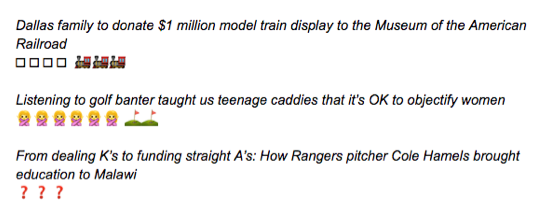Can your whole newsroom work together on headlines?
Amanda Wilkins, The Dallas Morning News,This is a series on Better News to a) showcase innovative/experimental ideas that emerge from the Knight-Lenfest Newsroom Initiative and b) to share replicable tactics that benefit the news industry as a whole. This “win” comes from Amanda Wilkins, who was until recently the audience development editor for The Dallas Morning News.
It’s 9 a.m. on a Friday. Editors have gathered in the Rio Grande conference room at The Dallas Morning News. The journalists stare at their screens, clicking on emojis to react to the upcoming headlines of the day.
The traditional morning news meeting has gone digital. Editors use Slack, a group messaging and collaboration tool, to not only inform one another about what stories are coming during the day, but to workshop headlines to attract the most readers possible. Each editor proposes two or three headlines on a Slack channel, and the meeting is focused on workshopping them to yield the best results. Emojis help raise questions, express approval, cast votes and more.
Welcome to the Headline Rodeo.

Question: What problem were you trying to solve, and why was solving the problem strategically important for your organization?
Answer: We were trying to find a way to improve headline writing and get the entire newsroom involved in our effort to improve headlines on our site. And we knew we had to do something more grand and more collaborative than passive training sessions and workshops.
Q: How is this approach related to Table Stakes (e.g. one of the 7 Table Stakes and/or an outgrowth of the Knight-Lenfest initiative, etc.)?
A: This relates to Table Stake No. 3 (“produce and publish continuously to meet your audience’s needs.”) It was important to us that we put more thought into not just when we publish, but how we publish. Headlines, of course, are the gateway into the stories we write, and we wanted to be more accessible.
Q: How did you go about solving the problem?
A: We established a channel in Slack called #headline-rodeo. It was born out of what was originally our morning digital meeting. In that meeting, we asked editors to pitch their stories via a headline — and only a headline — and everyone in the meeting would vote on their favorites. A vote was essentially, “I’d click that.” If a headline got a lot of votes, we’d talk about why we thought it was compelling. Conversely, if headlines got zero votes, we’d try to have a frank discussion about the reasons behind that.
We were having great conversations and learning a lot, but those learnings weren’t going beyond that morning meeting. So we changed up the meeting and took the Headline Rodeo to the whole newsroom via Slack.
We circulated the message that #headline-rodeo was the place to come ask for feedback and ideas for headline approaches, or to improve headlines for stories that were already published but weren’t gaining traction. It took some time to gather steam but, before long, we were collaborating on up to a dozen headlines per day.
Q: What worked?
A: We’ve been using these #headline-rodeo collaborations to drive A/B or multivariate headline tests so we can learn about click-through rate performance. In more than 700 conclusive headline tests we’ve run using Chartbeat, we’re seeing an average CTR increase of 45 percent. We’re using that data to find trends and commonalities to share with the newsroom so we can use that in our headline writing. It’s important to remember that these are homepage tests, so it’s a slice of the audience, but we think it’s an important slice that we should be thinking about when we’re trying headline approaches.
Q: What didn’t work?
A: Someone has to own it. It was originally intended to be a newsroom-wide effort that was merely championed by the Audience Team. But when an initiative is owned by everyone and no one at the same time, it often dies. After a sporadic start, we designated someone from the Audience Team each day to be the Headline Czar. That person is primarily responsible for responding to messages in the channel so that every request gets some attention. These days, several people usually chime in.
Q: What happened that you didn’t expect?
A: We discovered we had some serious headline chops in parts of the newsroom that we didn’t know about. For example, D.C. bureau chief Todd Gillman now has the reputation as the Headline King because he’s hopped into so many threads to pitch great ideas.
Before we launched the channel, I was a little concerned that workshopping headlines so publicly could lead to resentment or bruised feelings when ideas are critiqued. But I haven’t seen any of that.
Q: What would you do differently now? What did you learn?
A: We are on the free version of Slack, which doesn’t allow you to archive conversations. I wish we had kept a record of more of the collaborations, so we could circulate them in the newsroom and pat people on the back for their creativity and teamwork.
Q: What advice would you give to others who try to do this?
A: You have nothing to lose! It’s relatively low effort with high return for your audience and your newsroom. It gives people in your newsroom the opportunity to collaborate with colleagues they might not work with in a typical day.